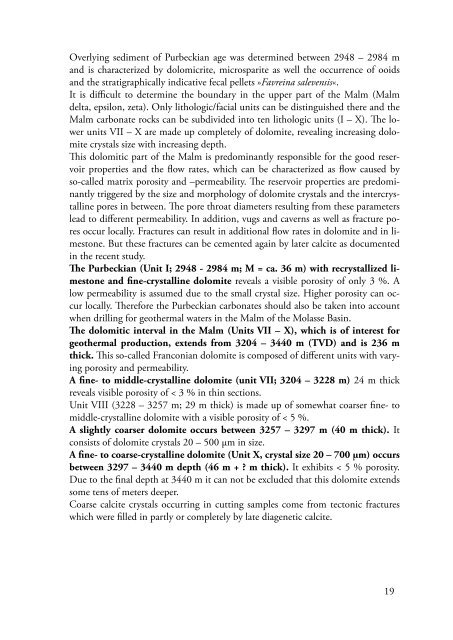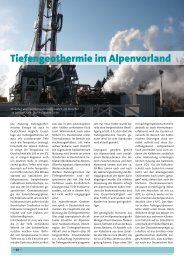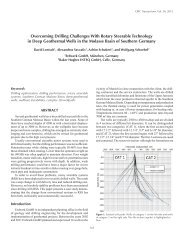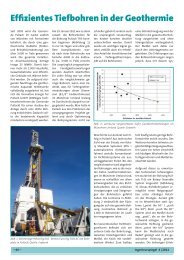Der Malm in der Geothermiebohrung Pullach Th2 ... - Erdwerk
Der Malm in der Geothermiebohrung Pullach Th2 ... - Erdwerk
Der Malm in der Geothermiebohrung Pullach Th2 ... - Erdwerk
Erfolgreiche ePaper selbst erstellen
Machen Sie aus Ihren PDF Publikationen ein blätterbares Flipbook mit unserer einzigartigen Google optimierten e-Paper Software.
Overly<strong>in</strong>g sediment of Purbeckian age was determ<strong>in</strong>ed between 2948 – 2984 m<br />
and is characterized by dolomicrite, microsparite as well the occurrence of ooids<br />
and the stratigraphically <strong>in</strong>dicative fecal pellets »Favre<strong>in</strong>a salevensis«.<br />
It is difficult to determ<strong>in</strong>e the boundary <strong>in</strong> the upper part of the <strong>Malm</strong> (<strong>Malm</strong><br />
delta, epsilon, zeta). Only lithologic/facial units can be dist<strong>in</strong>guished there and the<br />
<strong>Malm</strong> carbonate rocks can be subdivided <strong>in</strong>to ten lithologic units (I – X). The lower<br />
units VII – X are made up completely of dolomite, reveal<strong>in</strong>g <strong>in</strong>creas<strong>in</strong>g dolomite<br />
crystals size with <strong>in</strong>creas<strong>in</strong>g depth.<br />
This dolomitic part of the <strong>Malm</strong> is predom<strong>in</strong>antly responsible for the good reservoir<br />
properties and the flow rates, which can be characterized as flow caused by<br />
so-called matrix porosity and –permeability. The reservoir properties are predom<strong>in</strong>antly<br />
triggered by the size and morphology of dolomite crystals and the <strong>in</strong>tercrystall<strong>in</strong>e<br />
pores <strong>in</strong> between. The pore throat diameters result<strong>in</strong>g from these parameters<br />
lead to different permeability. In addition, vugs and caverns as well as fracture pores<br />
occur locally. Fractures can result <strong>in</strong> additional flow rates <strong>in</strong> dolomite and <strong>in</strong> limestone.<br />
But these fractures can be cemented aga<strong>in</strong> by later calcite as documented<br />
<strong>in</strong> the recent study.<br />
The Purbeckian (Unit I; 2948 - 2984 m; M = ca. 36 m) with recrystallized limestone<br />
and f<strong>in</strong>e-crystall<strong>in</strong>e dolomite reveals a visible porosity of only 3 %. A<br />
low permeability is assumed due to the small crystal size. Higher porosity can occur<br />
locally. Therefore the Purbeckian carbonates should also be taken <strong>in</strong>to account<br />
when drill<strong>in</strong>g for geothermal waters <strong>in</strong> the <strong>Malm</strong> of the Molasse Bas<strong>in</strong>.<br />
The dolomitic <strong>in</strong>terval <strong>in</strong> the <strong>Malm</strong> (Units VII – X), which is of <strong>in</strong>terest for<br />
geothermal production, extends from 3204 – 3440 m (TVD) and is 236 m<br />
thick. This so-called Franconian dolomite is composed of different units with vary<strong>in</strong>g<br />
porosity and permeability.<br />
A f<strong>in</strong>e- to middle-crystall<strong>in</strong>e dolomite (unit VII; 3204 – 3228 m) 24 m thick<br />
reveals visible porosity of < 3 % <strong>in</strong> th<strong>in</strong> sections.<br />
Unit VIII (3228 – 3257 m; 29 m thick) is made up of somewhat coarser f<strong>in</strong>e- to<br />
middle-crystall<strong>in</strong>e dolomite with a visible porosity of < 5 %.<br />
A slightly coarser dolomite occurs between 3257 – 3297 m (40 m thick). It<br />
consists of dolomite crystals 20 – 500 µm <strong>in</strong> size.<br />
A f<strong>in</strong>e- to coarse-crystall<strong>in</strong>e dolomite (Unit X, crystal size 20 – 700 µm) occurs<br />
between 3297 – 3440 m depth (46 m + ? m thick). It exhibits < 5 % porosity.<br />
Due to the f<strong>in</strong>al depth at 3440 m it can not be excluded that this dolomite extends<br />
some tens of meters deeper.<br />
Coarse calcite crystals occurr<strong>in</strong>g <strong>in</strong> cutt<strong>in</strong>g samples come from tectonic fractures<br />
which were filled <strong>in</strong> partly or completely by late diagenetic calcite.<br />
19







